Guest Editorial: Perils of a Peaceable Kingdom
by John Martin
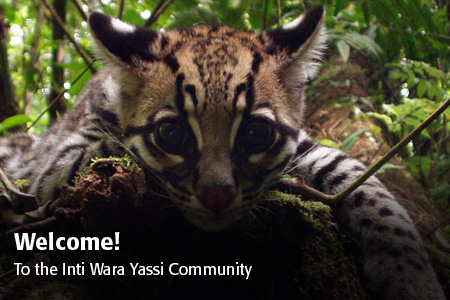
A Mini- Peaceable Kingdom
Two summers ago, I spent a month in Bolivia volunteering for Inti Wara Yassi (IWY), an organization with extensive grounds that rescues local wildlife from illegal private owners, who in many cases kept them in filthy conditions and subjected them to severe beatings. IWY cares for hundreds of animals: spider monkeys, capuchin monkeys, squirrel monkeys, coatis, howlers, pumas, ocelots, and a variety of birds and reptiles. At IWY they are rehabilitated and given as much freedom as they possibly can have without being a danger to themselves or people. After a lengthy quarantine process, many of the monkeys are eventually allowed to roam freely, only returning from the jungle at meal times. The mountain lions are walked around eight to eleven miles through the jungle every day depending on what mood they're in. They cannot be returned to the wild because they have no fear of people and have not learned to support themselves adequately by hunting.
Inti Wara Yassi will never turn down an animal or a volunteer when there is payment of the fee, which is between 145 and 178 dollars. The refuge is not funded by the government in any way. Bolivia is the poorest country in South America and it is very hard to find resources to help animals when people are suffering so much. In Bolivian culture, people tend to have little empathy with animals. People walking on the tourist trail would often grab at monkeys and demand that they be allowed to pet them. My friend Debra Lenik, who spent most of her day walking a 250 pound bear named Baloo, had people shout at her to either get Baloo out of their way or allow them to take a picture with him. At one point during my time at Inti Wara Yassi, two volunteers and a mountain lion who were walking by a creek were confronted by a duo of men who threw rocks at them and then released their dog on them.
IWY was founded by Juan Carlos Antezena in 1992 as an organization to help poor and orphaned children by teaching them how to make pottery and other crafts that could help them and their families. He often took the kids on hiking trips and one day they came across a forest fire and an abandoned peasant dwelling. Inside the house there was a small caged bird with clipped wings that was starving. They also later encountered some men getting a spider monkey drunk for their amusement. Juan Carlos took these events as a sign and made a resolution with the children that he would also dedicate himself to his nonhuman brothers--the trees and the animals.
Since that time, IWY has grown considerably and now consists of two large refuges staffed by professional veterinarians as well as volunteers. I volunteered at Parque Machia, a refuge which is located near the small town of Villa Tunari. My main job was taking care of one of the mountain lions, a very sensitive and affectionate beast named Sonko, walking him every day through the jungle.
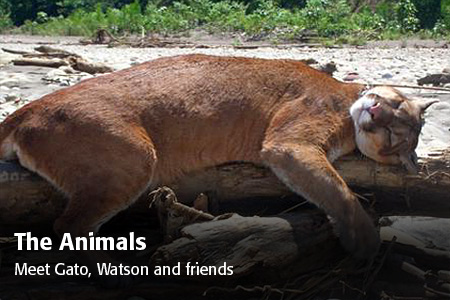
Parque Machia generates substantial revenue for the town by bringing in gringo backpacker volunteers who, sad to say, can afford to buy much more food and goods than the average Bolivian. Also, although most of the parque is not open to visitors, they do allow people to interact with the monkeys on a tourist trail and the profits are given to the local government.
In spite of this advantage to the community, some Bolivians are quite indifferent and even angry about the existence of the Parque. They believe that the land should belong to the people and not Juan Carlos and his army of animals, gringos and children. Parque Machia seems to be constantly in a state of crisis. Last year, the landlord who rented the area where the monkey quarantine is located spontaneously decided that she was going to sell the property. In a mere month, IWY was able to raise the equivalent of thirty four thousand dollars from friends and former volunteers in order to buy the land. This is especially impressive because every US dollar is worth seven bolivianos. Another big problem was that during my time at the refuge the park was robbed by some of the youth they were trying to help.
A Major Peril
However, park funding has little to do with the current peril Parque Machia has found itself in. According to volunteer Ali Wood, IWY received a letter in August from Feliciano Mamani, the mayor of Villa Tunari, stating that Parque Machia would be shut down to enable construction of a road connecting the town to Copacabana Baja (a community behind Parque Machia.) According to current volunteer Andres Gomez, the proposed seven and a half-kilometer road would cut directly through area currently inhabited by the parque. Inti Wara Yassi was given only two weeks to relocate themselves and their animals. Nena Baltazar, the refuge manager, was shocked to discover that the other inhabitants of Villa Tunari were unaware of this intended road. IWY in no way opposes the right of the community of Copacabana Baja to have a safe and viable access route from their location to the town, but recommends that a 300-meter bridge be constructed over the Chapare river instead. This would allow Parque Machia to continue and also give the people of Copacabana Baja more direct access to Villa Tunari. Ali Wood also claims that attempts have been made to construct a road through the area the park inhabits in the past, but that it collapsed because of the clay terrain. After another meeting in which the townspeople showed support for IWY, the mayor said that they would now have two months to relocate but that the road would be constructed and there was no getting around it. The idea for a bridge was quashed by the mayor as too expensive. However, he is also currently pursuing the construction of a multi-million-dollar bird-shaped lookout on the site of Inti Wara Yassi, making his financial concern suspect.
After the meeting with the mayor, the townspeople became strangely less forthcoming in their support for IWY. One person then produced a letter he had received which stated that if the inhabitants of Villa Tunari did not support the construction of the road, their water supply would be cut off. Also broader threats are now being made to change the leadership of IWY. The local government claims that Nena and Juan Carlos are not turning in the appropriate paperwork, are embezzling funds, and seriously mistreating the animals and youths. But according to Inti Wara Yassi, documents are in fact given to the appropriate council every year but that officials are hiding those documents to make Inti Wara Yassi look corrupt; they also deny that abuse is going on. (I did not see or hear of any during my stay.) According to Andres Gomez, Inti Wara Yassi believes that the goal of the local government is to remove Juan Carlos and Nena and turn Inti Wara Yassi into a money-making machine in which animals are kept in cages to amuse tourists, and profits are increased by removing funding for rehabilitation. Still other accusations, claims, and counterclaims are being made.
When I first heard about the situation at the refuge I felt immediately compelled to do something, but hindered by distance and by not being able to speak Spanish. I'm currently enrolled in college, so I cannot go there to investigate first-hand. I was told that the only way to help would be to publish an article to spread word about the situation. While receiving reports from both sides of the argument, I realized that it is ultimately a matter of whom I trust as I race against time to get something published. I trust Nena Balthazar; during my time at IWY, I had the opportunity to get to know her. My sense was that she was a dedicated and caring woman who spent nearly all of her time in service to the park. Although she is the head of Inti Wara Yassi, I most often saw her in the refuge's cafe washing the volunteers' dishes. I was also present when she learned that money had been stolen from the parque funds. Her emotional devastation could not have seemed more genuine. When I left Inti Wara Yassi, she expressed a great deal of gratitude to me for my help and made me feel very appreciated. As for Juan Carlos, the founder of Inti Wara Yassi, I did not get the opportunity to get to know him personally. However, he does have the trust of Jane Goodall, whom I admire. (I actually discovered Inti Wara Yassi because Juan Carlos was featured on a television program on Animal Planet in which Jane Goodall talked about her heroes in the field of animal conservation and rehabilitation.) Furthermore, the photographs produced by the opposition, of a youth at IWY being beaten, look faked. My experiences with the local people and their lack of respect for the animals also make me hesitant to trust them.
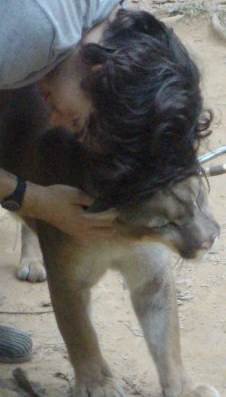 So I choose to side with IWY in this crisis. But I do not expect others to be convinced solely by my feelings on the subject, but encourage them to investigate the situation for themselves and to do what they can. If you have some media connection, this is at the very least a compelling story worth investigating. See below a file with a number of contacts: the IWY website, Animales SOS (who claim that the organization is corrupt), my own e-address, and that of other people associated with the park. Feel free to contact any of them.
So I choose to side with IWY in this crisis. But I do not expect others to be convinced solely by my feelings on the subject, but encourage them to investigate the situation for themselves and to do what they can. If you have some media connection, this is at the very least a compelling story worth investigating. See below a file with a number of contacts: the IWY website, Animales SOS (who claim that the organization is corrupt), my own e-address, and that of other people associated with the park. Feel free to contact any of them.
John Martin is an attender with the Animal Kinship Committee, sponsor of The Peaceable Table. The photo at left shows a tender moment between John and his mountain lion friend Sonko.
[Show links and email addresses]
Inti Wara Yassi's website: www.intiwarayassi.org/articles/volunteer_animal_refuge/home.html
Animales SOS: www.animalessos.org/pag/english/index_e.html
e-mail addresses
the e-mail address for the IWY website (English or Spanish okay) : intiwarayassi@gmail.com
Juan Carlos and Nena Balthazar (speak mostly Spanish) : ciwy99@yahoo.com,
Johnny and Luis Morales, the vets at the park (speak a little English, mostly Spanish) : jhonny.d.l@hotmail.com, lumor23@hotmail.com
Pea Macpherson who is coordinating efforts to save the park (speaks English) : peamacpherson@gmail.com
Paola, a semi-permanent volunteer at the park (Speaks only Spanish) : lucianyta@hotmail.com
My own e-address: bandittinkerpirate@gmail.com
also if you're on facebook, look up Andre Jimenez Gomez, who has been particularly helpful and speaks English.
We invite responses to editorials or any other feature of PT for our next issue's letter column: graciafay@gmail.com.
News Notes
Interfaith-Interspecies Service
On Sunday, September 28th, in London, Ontario, Canada, the annual blessing of the animals, open to all people and their animal companions, was held at Trinity United Church. A number of churches offer such events at this time of year to coincide with the feast day of St. Francis of Assisi. What is unique at Trinity United is the effort to work with other faith traditions. The clergypersons were the Rev. Paul Browning of Trinity United and the Ven. Mike Shaw, a Buddhist priest from Peach Blossom Sangha. The Ven. Mike Shaw is a member of the Christian Vegetarian Association (CVA), and its advisor regarding Buddhism and Daoism.
--Contributed by Mike Shaw and Steve Kaufman
Foreigners Farm Hungry Africa--for Export
Some of the world's richest nations are coming to Africe to grow crops and export the yields, hoping to turn the global epicenter of malnutrition into a
breadbasket for themselves. www.latimes.com/news/nationworld/world/la-fg-food28-2008sep28,0,5076270.story
--Contributed by Diana Dunningham Chapotin
Diana Chapotin is the
International Secretary of the Theosophical Order of Service.
Good Egg Award to Friends House
 Friends House, the hospitality center of Britain Yearly Meeting of Friends, was one of the groups receiving the Good Egg Award from Compassion in World Farming, given for sourcing of eggs from cage-free hens. We look for the day when Friends commit firmly to a compassionate plant-based diet, but in the meantime, every step deserves encouragement.
Friends House, the hospitality center of Britain Yearly Meeting of Friends, was one of the groups receiving the Good Egg Award from Compassion in World Farming, given for sourcing of eggs from cage-free hens. We look for the day when Friends commit firmly to a compassionate plant-based diet, but in the meantime, every step deserves encouragement.
--Contributed by Marian Hussenbux
Letters:
The essay in the Oct. issue, "Whatever One Sows," made my heart beat faster--One of the elements that led me to veganism was the sense that the suffering of both humans and animals piles up in a corner of the universe as a weight - in more than a strictly metaphorical sense . . .
--Debbie Elliott
Book Review: Guided by the Faith of Christ
By Stephen R. Kaufman
Kaufman, Stephen R. Guided by the Faith of Christ: Seeking to Stop Violence and Scapegoating. Cleveland: Vegetarian Advocates Press, 2008. 256 pp. $14.00. Paperback.
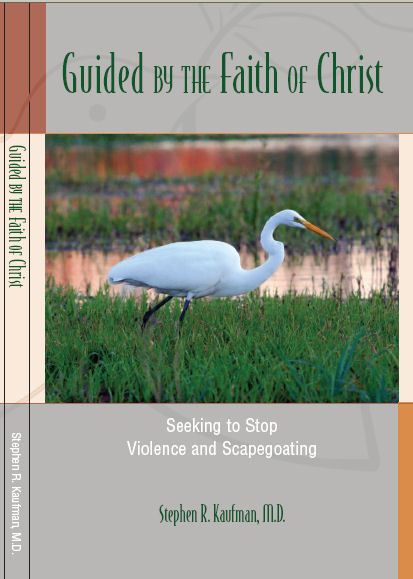 Kaufman begins this important study with an overview of Girardian theory. Its basic tenet is that humans are afraid of death, and try to cover up this fear by competing with others for material possessions, power, and prestige. Another way to try to dispel the fear of death is by setting up elaborate arbitrary rules, and by persecuting ("scapegoating") those who violate such rules, sometimes merely by existing. The two methods are intimately connected. They create an uneasy stasis in society, keeping aggressive urges in check, but at the cost of injustice, cruelty and suffering. Sooner or later, however, the balance is disturbed and violence breaks out again.
Kaufman begins this important study with an overview of Girardian theory. Its basic tenet is that humans are afraid of death, and try to cover up this fear by competing with others for material possessions, power, and prestige. Another way to try to dispel the fear of death is by setting up elaborate arbitrary rules, and by persecuting ("scapegoating") those who violate such rules, sometimes merely by existing. The two methods are intimately connected. They create an uneasy stasis in society, keeping aggressive urges in check, but at the cost of injustice, cruelty and suffering. Sooner or later, however, the balance is disturbed and violence breaks out again.
After the basic exposition, Kaufman examines the Hebrew Bible ("Old Testament") in the light of Girardian theory. He reaches many surprising and intriguing insights; at least they surprised me--I felt I should have thought of them before.
For example: in Genesis 22, neither God nor the angel commands, or even asks, Abraham to sacrifice the ram. Not even a hint is given. It seems that the patriarch concluded quite on his own that the sacred violence, having been deflected from Isaac, had to be redirected to another innocent victim. It would have been better if he had thought: "This poor ram, like my son, is a living and innocent being, perhaps also loved and loving. Why should he die?" Then he should have freed the ram from the thicket and let him go, alive and well. Perhaps Abraham was given not one but two tests - and he failed the second one.
Kaufman's take on the seventh chapter of Joshua really upended me. Kaufman suggests that Joshua may have loaded the dice against Achan and planted the spoils in his tent, and/or forced him to confess under torture - all to avoid bearing the blame himself for the defeat at Ai. All these decades I had never considered this alternative, but it is entirely possible. (Contrast this story with the episode in Silas Marner in which Silas is framed for theft by his best friend--and the lots which the church elders cast to find out the truth declare that Silas is guilty. Is George Eliot among the prophets?) One cannot assume the Bible always tells the whole, or the true, story. Sometimes one has to dig beneath the surface and explore alternative explanations.
The teachings and doings of Jesus were aimed at eliminating scapegoating /sacred violence. There is an intimate connection between extreme concern with ritual purity and the predisposition towards the sacred violence of scapegoating. For as long as there have been human societies, full of fear (of death) and envy ("mimetic rivalry"), social cohesion has been built up by establishing Rules (often arbitrary ones) and inciting hatred and violence towards outsiders who live by different rules and towards outcasts who violate the rules - sometimes by who they are or by a disease from which they suffer. What Jesus did, and does, is to accept the outcast and teach us to forsake fear, hatred and violence. We are instead to live by loving and trusting God and loving our fellow beings, humans and animals. (At the same time, it is important to remember that Jesus is not the first, or last, Jewish teacher to give a message of this nature.)
Kaufman offers some wonderfully suggestive insights into Jesus. My favorite is his interpretation of the feeding of the multitude. Kaufman's idea is that Jesus inspired and encouraged the hoarders to share their provisions with the less provident.
After examining the Bible, Kaufman moves forward to modern times and analyzes contemporary issues, including animal rights. Then he goes back chronologically to the early chapters of Genesis. Adam, Kaufman points out, did not just name every species of animal. he named every individual creature - and thus made it psychologically difficult or impossible to reduce them to food or sacrificial victims.
There is one point, not crucial ot Kaufman's thesis, in which I disagree with him. It is the acceptance (p.91) of some very angry and condemning words in John 8: 42-44 as authentic words of Jesus, on the grounds that they were addressed to "those who opposed him." But this demonizing language is not directed towards his opponents but towards "the Jews who believed [or "had believed"] in him" (John 8:31). These followers of Jesus object to being told "the Truth shall make you free" because, they say, they are descendants of Abraham, and as such have never been slaves. This is unconvincing, however, because every year at Passover, and in prayers throughout the year, Jewish people remind themselves that they participate in the experience of their ancestors who were slaves in Egypt. The story is probably a fiction, or at least fictionalized. The misunderstanding is not very credible, and the ferocious overreaction to it on Jesus' part even less credible.
Because he is addressing an audience of biblically-based Christians, Kaufman limits his study of Jesus' teachings to the canonical books of the Western Bible. But if we also look into such works as the Gospel of Thomas and the Gospel of the Hebrews, we can find Jesus speaking out strongly against flesh-eating and other instances of scapegoating, as well as other mistreatment of animals. The same is true of Muslim legends and traditions. (These sources - from Egypt, Judea and Arabia - form what we may call a Levantine Triangle.)
I strongly recommend Kaufman's book, as it is both powerfully thought-provoking and spiritually uplifting. For those unfamiliar with the work of René Girard, it might serve as an introduction to it.
-Benjamin Urrutia
Gems
On Cruelty
 "An infallible characteristic of meanness is cruelty. Men who have practiced tortures on animals without pity, relating them without shame, how can they still hold their heads among human beings?" ~ Samuel Johnson (1709 - 1784), British humanitarian, lexicographer and essayist, and sometime guardian of Hodge the Cat. PT38
"An infallible characteristic of meanness is cruelty. Men who have practiced tortures on animals without pity, relating them without shame, how can they still hold their heads among human beings?" ~ Samuel Johnson (1709 - 1784), British humanitarian, lexicographer and essayist, and sometime guardian of Hodge the Cat. PT38
--Contributed by Lorena Mucke
On Becoming Vegetarian
"I began to realize that I was disobeying my rule of life which says: I will not ask anyone to do for me things that I would refuse to do for myself."
--Peace Pilgrim
Recipes
Brodo Italiano (Basic Italian Broth)
makes about 1 ½ - 2 quarts
1 yellow onion, chopped
1 stalk of celery, chopped
2 carrots, peeled and chopped
1 clove garlic, chopped
¼ cup chopped fresh Italian parsley
¼ cup roughly torn fresh basil
2 T. extra virgin olive oil
½ tsp. sea salt, or to taste
freshly ground black pepper, to taste
10 cups spring water
In large stock pot, warm olive oil and add onion, carrots, and celery. Cook until onion is soft and translucent. Add parsley, garlic and basil; cook for one minute. Add sea salt, black pepper and water. Bring to boil; then reduce heat and simmer, covered, for 20 minutes. Strain. Reserve vegetables so that they may processed and used in another recipe.
This broth recipe or any near variation will result in a terrific Italian broth for soups or any recipe requiring a good broth.
--- Angela Suarez
Sautéed Belgian Endive
serves 4
2 ½ T olive oil
2 large Belgian endives, cut in half lengthwise
sea salt and freshly ground black pepper, to taste
2 T dry white wine
Heat oil. add endives, cut side down, add salt and pepper. Cover and cook 8-10 minutes, until wilted and undersides are celery color.
Carefully turn endive and season with salt & pepper. Cover and cook 5 minutes. Drizzle the wine over the endives. Cook uncovered for one minute. Turn onto platter and spoon the pan juices over the endives.
Great for antipasti -- pair on platter with sautéed radicchio and sautéed mushrooms.
--- Angela Suarez
Zuppa di Cannellini e Rosmarino (Cannellini and Rosemary Stew)
serves 4 -6
 3 T. extra virgin olive oil
3 T. extra virgin olive oil
1 medium yellow onion, chopped
1 lb. carrots, peeled, cut into chunks
¼ tsp. powdered rosemary
tiny pinch freshly grated nutmeg
2 ribs celery, chopped
3 cloves garlic, finely chopped
small pinch dried crumbled mint
sea salt, to taste
freshly ground black pepper, to taste
2 cups spring water
1 lb. cannellini beans, soaked in water overnight, then cooked tender, and drained
1 Roma (plum) tomato, peeled, seeded and chopped
1 tsp. balsamic vinegar
Preheat oven 400° F.
Brush carrots with 1 T. olive oil and toss with ¼ tsp. sea salt, a generous grinding of black pepper, rosemary and pinch of freshly grated nutmeg. Place in a covered roasting pan and place in oven for 30 minutes, or until carrots are tender.
In large soup pot, sauté onion and celery until onion is translucent. Then add garlic and mint . Adjust seasoning with salt and black pepper. Add 2 cups spring water and cooked cannellini (about 3 - 4 cups), bring to boil, simmer 10 minutes. Add roasted carrots, chopped tomato and balsamic. Cook 3 more minutes. Serve immediately.
This is a delicious winter stew. Serve with baked, slightly crunchy polenta for a very pleasant meal.
--- Angela Suarez
My Pilgrimage: A Bag of Raw Flesh
by Amanda Pankiw
 I grew up on a farm in rural Saskatchewan, Canada. We raised cattle, chickens, and pigs. Every night for dinner we would have meat. Growing up I knew that animals had a personality and feelings from watching our animals. Our family loved our animals, but still some of them ended up on our dinner table.
I grew up on a farm in rural Saskatchewan, Canada. We raised cattle, chickens, and pigs. Every night for dinner we would have meat. Growing up I knew that animals had a personality and feelings from watching our animals. Our family loved our animals, but still some of them ended up on our dinner table.
When I moved away from home, I didn't eat as much meat because it was so expensive and I couldn't afford it on my small budget. I'd always thought of becoming a vegetarian and once in a while I would stop eating meat altogether, but I would always go back to it.
Then, one day, I was doing my weekly grocery shopping. That week the store that I shopped at was having a meat sale. They gave the customers a big brown bag to fill up with meat and then the customer would get ten percent off. The sight of this made me sick to my stomach. A big bag of raw flesh. All of these people wheeling their carts around with bags of flesh in them. I quickly got the rest of the things that I needed and got out of there.
On my drive home I thought about how wrong it was to eat animals. There are so many alternatives available to us. I started doing some research on the internet and at a bookstore. I visited the website of People for the Ethical Treatment of Animals (PETA). It showed pictures of the conditions animals often live in, and it made me cry. That day I decided to become a vegan.
It was difficult at first and I even had one backslide. But I found an awesome cookbook called How it All Vegan. In it, there are easy-to-make recipes and great tips.
The greatest challenge, though, remains eating out. Sometimes the only thing that I can get is fries, but when I think about it, it's all worth it.
From Voices from the Garden, edited by Sharon Town and Daniel Town. Used by permission of the editors.
Pioneer: Peace Pilgrim (Mildred Norman Ryder), 1908-1981
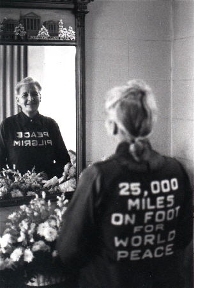 The woman who became Peace Pilgrim was born Mildred Lisette Norman in Egg Harbor City, New Jersey; ironically, on a poultry farm. Her family was not well-off, but her parents created for their children an atmosphere of kindness and security. For several decades, her outer life was unremarkable. It included marriage to one Stanley Ryder in 1933; they divorced in '46.
The woman who became Peace Pilgrim was born Mildred Lisette Norman in Egg Harbor City, New Jersey; ironically, on a poultry farm. Her family was not well-off, but her parents created for their children an atmosphere of kindness and security. For several decades, her outer life was unremarkable. It included marriage to one Stanley Ryder in 1933; they divorced in '46.
But her interior life was an extraordinary process of spiritual awakening. She loved nature, and would seek guidance from God during solitary walks. In her booklet "Steps to Inner Peace," she says that she learned very early that it is easy to make money, but that spending it for self-gratification is meaningless. Eventually she found that expressing our oneness with others in service is the true and happy way to live. But she was in conflict, wanting both the gratifications of the old self-oriented life, and a life of giving. Eventually she committed herself wholly to service, relinquished all attachments, and found total release from ego-centeredness, entering a unitive state. Peace, she learned, is not merely a state of non-conflict, but stems from the limitless power of love.
She took the name Peace Pilgrim and vowed to walk until humanity has found peace. Her journey as a kind of nun-errant began Jan. 1, 1953, in Pasadena, California, continuing as she crossed the United States more than six times over the following 28 years, also going through Canada and parts of Mexico. She carried no money or spare clothing and had no possessions save for a few personal items in the pockets of her tunic. In front the tunic read "Peace Pilgrim," and in back "25,000 miles on foot for world peace" (after 25,000, reached in 1964, she stopped counting). This message became a point of engagement for  discussion with those she met. She soon came to be in demand as a speaker at churches and universities, on radio and television.
discussion with those she met. She soon came to be in demand as a speaker at churches and universities, on radio and television.
She never asked for food or shelter, but fasted and slept outdoors until they were given freely. She lived her peace-commitment also in diet, maintaining a firm vegetarian regimen. As she says in her book, compiled by her supporters,
"I have extended my pacifism to include non-harming of creatures as well as non-harming of human beings. Therefore for many years I have not eaten flesh--not meat, fowl, or fish. I also don't use furs or feathers, leather or bone. . . . Some people may miss the eating of flesh, but I do not. I don't crave animal flesh any more than the average person craves human flesh. I think most pacifists--in fact, most modern human beings--would not eat flesh if they had to kill the creatures themselves. I think if you were to visit a slaughterhouse it might encourage you to extend your pacifism to include nonharming of creatures . . ." (Peace Pilgrim: Her Life and Work in Her Own Words, p. 113)
While being driven to a speaking engagement in July of 1981, she was killed in a traffic accident. Her centennial was celebrated this past July.
From "Reflections on Peace Pilgrim's Life," taken from an interview with John Robbins:
. . . . What I understand of Peace Pilgrim’s diet is that she was a vegetarian. And that’s really remarkable because she was staying wherever she was offered shelter and eating, presumably, what she was offered. I can imagine that that took a lot of commitment on her part . . . Here again, she was ahead of her time.
Philosophically, to not eat meat was totally consistent with her attitude for respect for life. Why eat food that stems from violence if you’re trying to create a peaceful world? It’s that old prayer: “Let there be peace on earth, and let it begin with me.” When you take responsibility for your part in the great peace and the great healing that our times require, then you ask of each of your life choices, “Is this consistent with a peaceful way of being, or is this not?” . . . Your choices become dictated by what generates more peacefulness, a higher quality of consciousness, greater life and vitality, and a greater ability to contribute to the well-being of others.. . . . I find it’s socially easier now than it was when Peace Pilgrim was paving the way.
Peace Pilgrim knew intuitively the connection between our diets and the level of violence in the world. I certainly sense that when we are drawing our energy from violence, the probability of us acting out violence in our own lives is increased . . . .
Poetry
Upon the Snail
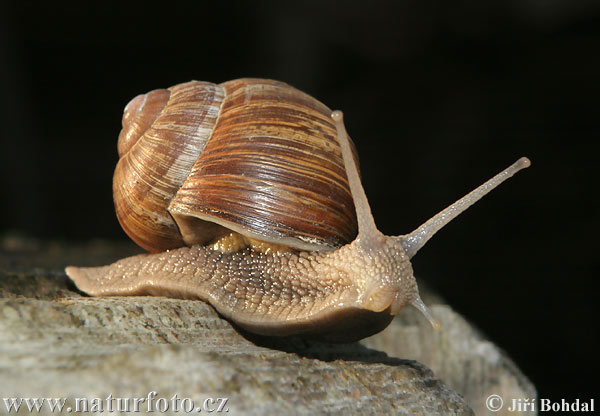 She goes but softly, but she goeth sure;
She goes but softly, but she goeth sure;
She stumbles not as stronger creatures do:
Her journey's shorter, so she may endure
Better than they which do much further go.
She makes no noise, but stilly seizeth on
The flower or herb appointed for her food,
The which she quietly doth feed upon,
While others range, and gare, but find no good.
And though she doth but very softly go,
However 'tis not fast, nor slow, but sure;
And certainly they that do travel so,
The prize they do aim at, they do procure.
--John Bunyan, 1628-1688
The Peaceable Table is
a project of the Animal Kinship Committee of Orange Grove Friends Meeting, Pasadena, California. It is intended to resume the witness of that excellent vehicle of the Friends
Vegetarian Society of North America, The Friendly
Vegetarian, which appeared quarterly between 1982 and
1995. Following its example, and sometimes borrowing from its
treasures, we publish articles for toe-in-the-water
vegetarians as well as long-term ones, news notes, poetry, letters, book
and film reviews, and recipes.
The journal is intended to be
interactive; contributions, including illustrations, are
invited for the next issue. Deadline for the December issue
will be Nov. 27, 2008. Send to graciafay@gmail.com
or 10 Krotona Hill, Ojai, CA 93023. We operate primarily
online in order to conserve trees and labor, but hard copy
is available for interested persons who are not online.
The latter are asked, if their funds permit, to donate $12 (USD) per year. Other
donations to offset the cost of the domain name and server are welcome.
Website: www.vegetarianfriends.net
Editor: Gracia Fay Ellwood
Book and Film Reviewers: Benjamin Urrutia & Robert Ellwood
Recipe Editor: Angela Suarez
NewsNotes Editors: Lorena Mucke and Marian Hussenbux
Technical Architect: Richard Scott Lancelot Ellwood


 So I choose to side with IWY in this crisis. But I do not expect others to be convinced solely by my feelings on the subject, but encourage them to investigate the situation for themselves and to do what they can. If you have some media connection, this is at the very least a compelling story worth investigating. See below a file with a number of contacts: the IWY website, Animales SOS (who claim that the organization is corrupt), my own e-address, and that of other people associated with the park. Feel free to contact any of them.
So I choose to side with IWY in this crisis. But I do not expect others to be convinced solely by my feelings on the subject, but encourage them to investigate the situation for themselves and to do what they can. If you have some media connection, this is at the very least a compelling story worth investigating. See below a file with a number of contacts: the IWY website, Animales SOS (who claim that the organization is corrupt), my own e-address, and that of other people associated with the park. Feel free to contact any of them. 
 Friends House, the hospitality center of Britain Yearly Meeting of Friends, was one of the groups receiving the Good Egg Award from Compassion in World Farming, given for sourcing of eggs from cage-free hens. We look for the day when Friends commit firmly to a compassionate plant-based diet, but in the meantime, every step deserves encouragement.
Friends House, the hospitality center of Britain Yearly Meeting of Friends, was one of the groups receiving the Good Egg Award from Compassion in World Farming, given for sourcing of eggs from cage-free hens. We look for the day when Friends commit firmly to a compassionate plant-based diet, but in the meantime, every step deserves encouragement.  Kaufman begins this important study with an overview of Girardian theory. Its basic tenet is that humans are afraid of death, and try to cover up this fear by competing with others for material possessions, power, and prestige. Another way to try to dispel the fear of death is by setting up elaborate arbitrary rules, and by persecuting ("scapegoating") those who violate such rules, sometimes merely by existing. The two methods are intimately connected. They create an uneasy stasis in society, keeping aggressive urges in check, but at the cost of injustice, cruelty and suffering. Sooner or later, however, the balance is disturbed and violence breaks out again.
Kaufman begins this important study with an overview of Girardian theory. Its basic tenet is that humans are afraid of death, and try to cover up this fear by competing with others for material possessions, power, and prestige. Another way to try to dispel the fear of death is by setting up elaborate arbitrary rules, and by persecuting ("scapegoating") those who violate such rules, sometimes merely by existing. The two methods are intimately connected. They create an uneasy stasis in society, keeping aggressive urges in check, but at the cost of injustice, cruelty and suffering. Sooner or later, however, the balance is disturbed and violence breaks out again. "An infallible characteristic of meanness is cruelty. Men who have practiced tortures on animals without pity, relating them without shame, how can they still hold their heads among human beings?" ~ Samuel Johnson (1709 - 1784), British humanitarian, lexicographer and essayist, and sometime guardian of Hodge the Cat.
"An infallible characteristic of meanness is cruelty. Men who have practiced tortures on animals without pity, relating them without shame, how can they still hold their heads among human beings?" ~ Samuel Johnson (1709 - 1784), British humanitarian, lexicographer and essayist, and sometime guardian of Hodge the Cat.  I grew up on a farm in rural Saskatchewan, Canada. We raised cattle, chickens, and pigs. Every night for dinner we would have meat. Growing up I knew that animals had a personality and feelings from watching our animals. Our family loved our animals, but still some of them ended up on our dinner table.
I grew up on a farm in rural Saskatchewan, Canada. We raised cattle, chickens, and pigs. Every night for dinner we would have meat. Growing up I knew that animals had a personality and feelings from watching our animals. Our family loved our animals, but still some of them ended up on our dinner table. The woman who became Peace Pilgrim was born Mildred Lisette Norman in Egg Harbor City, New Jersey; ironically, on a poultry farm. Her family was not well-off, but her parents created for their children an atmosphere of kindness and security. For several decades, her outer life was unremarkable. It included marriage to one Stanley Ryder in 1933; they divorced in '46.
The woman who became Peace Pilgrim was born Mildred Lisette Norman in Egg Harbor City, New Jersey; ironically, on a poultry farm. Her family was not well-off, but her parents created for their children an atmosphere of kindness and security. For several decades, her outer life was unremarkable. It included marriage to one Stanley Ryder in 1933; they divorced in '46. discussion with those she met. She soon came to be in demand as a speaker at churches and universities, on radio and television.
discussion with those she met. She soon came to be in demand as a speaker at churches and universities, on radio and television.  She goes but softly, but she goeth sure;
She goes but softly, but she goeth sure;